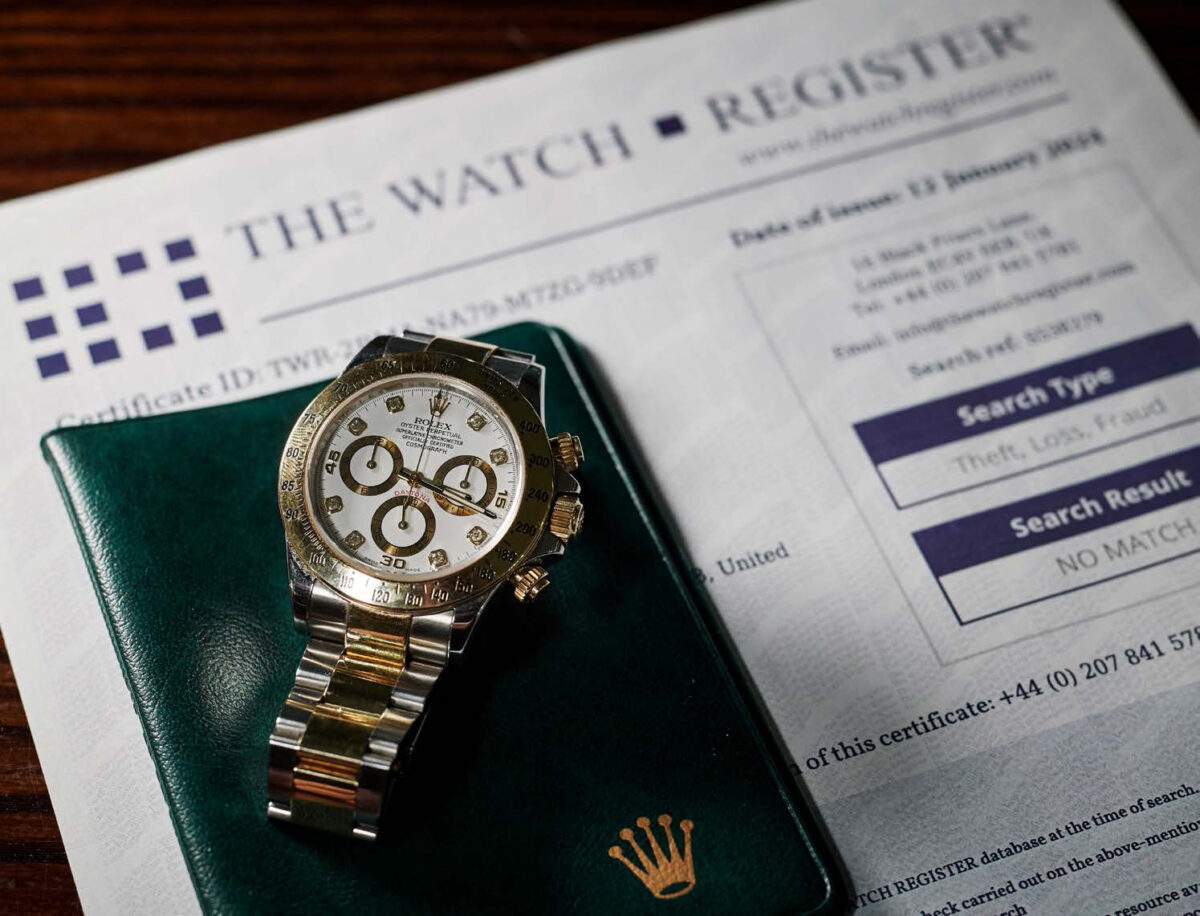
Watch crime has been hitting the headlines for the last two years with increasingly strident calls for action. Covert footage recently released by the Metropolitan Police gave an insight into their efforts to trap and arrest thieves, but what can we, as watch owners, do to protect ourselves?
One of the easiest steps we can take is to record the serial numbers of our watches. This alone makes your watch identifiable and more recoverable. Working as a registered watch valuer, the number of times I have seen watch paperwork without the serial number correctly filled in or insurance valuations with no serial number listed because they were inside the watch case is staggering.
The watch community needs to tighten up, from retailers to owners, valuers to insurers. We would never consider insuring a car or reporting one stolen without the registration number, so why would we do it for watches, especially as there is no DVLA for our hobby?
But wait. The next best thing to a DVLA for watches is The Watch Register, the world’s largest database of lost, stolen, and counterfeit watches, which will celebrate 10 years in business in 2024.
I am honoured to have been asked to write The Watch Register’s Anniversary Report, which launched for general release this week and is available to download here.
The report indicates they have over £1.5 billion worth of watches searchable on their records. Sadly, there are many more reported to The Watch Register that have little hope of recovery due to a lack of a serial number.
The report states that more than 50% of crime victims do not make a Police report as they believe there is little chance of getting their watch back, but evidence shows that The Watch Register is locating more watches every year and finding them faster with over 50% of recovered watches being found within 12 months of the loss.
The current hit rate stands at 4 stolen watches located by the company every day.
In the last few years, there has been a proliferation of databases claiming to identify stolen watches. These may be set up by the manufacturers themselves, or independent watch dealers.
Sadly, this is a case of ‘more is less…’. Small databases that rely on accurate user input without The Watch Register’s years of experience in data cleaning create a false sense of security.
Furthermore, a crowded market with multiple registration sites significantly increases the chances of a stolen watch not being picked up, as a trader may search a different database to the one on which a stolen watch was registered.
With few records to compare against and potential typos in the search fields, a ‘no match’ result is almost inevitable and equally meaningless.
The watch-owning public believes that all databases have access to the same data, whether a new start-up, an established organisation, or the manufacturer themselves.
Unfortunately, the opposite is true. Your ‘clear’ search result may come from a mistyped check against a few thousand records with a limited shelf life. If a match happens to be made, there is no follow-up or recovery to reunite you with your watch. Smaller databases put no obligation whatsoever on the searcher to do anything about a match, or even secure the watch.
With no internal investigation or follow-up, they could even be used by the thieves themselves to check whether a stolen watch is too hot to sell.
Human involvement, such as reacting to a match, contacting the searcher, and securing a watch pending further investigation, costs money, and inevitably, these new, smaller, ‘open’ databases are free. As the saying goes, ‘If the product is free, then you are the product’, and the marketing opportunities for such databases are undeniable.
When it comes to data, ‘Big is Beautiful’. The Watch Register’s records go back 10 years, but its parent company, The Art Loss Register, has recorded losses for almost 35 years, with the Police and Insurer’s loss reports going back further still, making them by far the largest in the world.
The Watch Register are experts in their field, being the only UK Police-accredited database and working closely with Europol and other global law enforcement agencies. They actively scour auction house catalogues for stolen watches, recovering watches sometimes decades after a theft.
By contrast, the wide uptake of The Watch Register database checks by UK watch dealers and pawnbrokers can see a stolen watch identified, held, and returned to the owner within a matter of days after the theft.
Their experience extends to cross-border negotiations and the repatriation of stolen watches globally. While this is not a free service, their expertise comes at a fraction of the cost of a private legal recoveries firm.
Their involvement on recoveries is not time-limited, whereas police forces – whose primary interest is the criminal investigation – will typically not take action on recovering a stolen watch when it reappears years after the theft and has passed through multiple owners.
The Watch Register’s 10-year Anniversary report details the company’s achievements to date, its importance to the numerous stakeholders it works with, and its vision for the future. The power of their search algorithms and the dedication of their recovery team are all unlocked with just a serial number.
Adrian Hailwood is a watch consultant, valuer, author and speaker. To learn more visit www.adrianhailwood.com.

